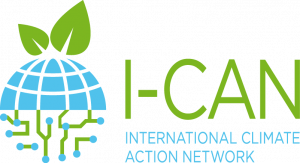1. Briefly describe the activity you delivered in your classroom, including the ages of children/young people :
This climate change activity focuses on the learners’ making connections between climate change, climate justice and the SDGs. It was used in a workshop [ Liverpool John Moores University] with 40 student teachers to introduce them to the I Can project and to help them understand more about the SDGs and climate justice.
The intention was to build their critical thinking skills and get them considering how to integrate an active methodology [ as used in the I Can project/ see IO1 ] into their own classroom teaching. It was delivered as part of a module on ‘Global Learning’.
The students worked in groups of 3 to 5 students.
They were firstly asked to consider the question ‘What do we all need to have a good life’? What rights do you think everyone should have? This led to a detailed discussion.
Each group was then given a set of ICONS, one for each SDG and asked to compare their initial discussion ideas with these targets. They then got given a set of climate connection cards, they read each one and decided which SDG it related to.
These were then placed in a diagram, of their own design, on the table.
They soon realized that 1 connection often linked to more than 1 SDG, so their diagrams grew, developed, and got more complicated.
2. How did the activity address climate change? :
This activity revisited the 17 universal sustainable development goals [ SDGs] , these can be seen as a helpful list of social, economic and environmental rights and targets. conversation with some hard thinking going on. They were then reminded that the SDGS are all interconnected and dependent on each other. It addressed climate change and climate justice by giving the learners the opportunity to realize how complicated the connections are between the impacts of climate change and the interconnectedness of the SDGs. It also deepened their understanding of the problems people face in different parts of the world.
3. What was a success? What was the impact on the pupils/school?
At the end of the practical activity the students had an excellent discussion and went into depth on the consequences of climate change and its impact across the planet on peoples’ lives.
All the groups moved around the classroom and examined other groups diagrams as these were all different. The conversations that happened as they examined each diagram helped to strengthen understanding and enabled the students to begin to feel more confident about voicing their views and ideas. It also showed that there are different ways to approach an issue and that its multi layered and complicated.
Taking part in this and similar activities had a powerful impact on the students’ thinking and in the long term may influence their future approaches to teaching climate change / climate justice. Many felt more confident about using a similar methodology in a classroom with pupils and showed a ‘desire and passion to initiate changed thinking in the future relating to their teaching of climate change.’
The university lecturer observing this workshop stated that they considered:
" [climate justice] is the single most important thing affecting us all, and the way to move forward is through education.’’
- Any other comments:
Students made comments at the end of the workshop about its impact on their thinking:
- I felt I had a " deeper understanding on teaching about the climate crisis"
- ‘’I was hoping to have a deeper and more meaningful understanding of what is happening around the world and that has happened’’
Quite a few students talked about their need to ‘understand their roles as educators within this crisis’. They thought the workshop might ‘’support them with combating climate anxiety in their future pupils and felt strongly that there was a need for teachers to give young people information on the climate crisis and that they needed to understand how to best embed this into their own lessons.’’
The workshop and this activity based on I02 impacted by as one student put it : ‘ building my confidence in including climate justice issues within lessons. This has been met by better understanding the language used around climate justice and practical ideas for activities to use with a range of ages.’’
Other students felt that the activity within the workshop had ‘Increased their teaching skills to promote critical thinking, debate, and discussion on complex and controversial issues’
‘’I feel a lot more aware and informed now after taking part so I am glad that I have been fully engaged in it, I have a better understanding of key issues and am beginning to identify ways in which I can best communicate this information to the children I will be teaching’’
A university lecturer involved in the session also commented that: ‘’One of the aims of the teaching activity was to build empathy and promote critical thinking, debate and discussion. The workshop certainly encouraged this amongst the student teachers’’ and went on to say:
‘’They are now able to see that different methodologies can support pupils with a better set of vocabulary regarding the climate topic that will enable them to develop oracy and open discussion amongst their peers both in the classroom and outside the classroom. This may transfer into discussions with family about making changes such as recycling, using less cars and walking, reading more than watching tv.’

